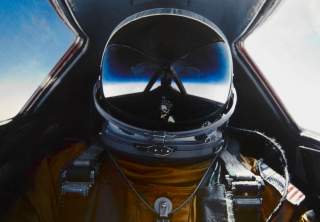Now Is Your Chance to Buy an Ultra-Rare Original SR-71 Blackbird Pilot Helmet on Ebay
What are you waiting for?
“The next component on the right side of the helmet towards the back and right about horizontal center of the head was what was called a take up reel. This reel was a device that was attached to a spool that a string was wound around, which was in turn attached to several points of the neoprene face seal and laced through several eyelets on the inside of the helmet. This system was used to draw the face seal snugly against the face to prevent any type of leakage between the two cavities of the helmet. At the end of the flight, the reel was relaxed and the seal loosened to allow removal of the helmet. In the very back and dead center was attached the two oxygen hoses that connected the suit’s oxygen system to the plane’s oxygen supply via the seat kit. The hoses fed into the helmet’s regulator, which will be discussed later.
“On the inside of the helmet and on the inside of the face cavity, the face seal was attached to a bigger, looser drape-like piece of airtight material that was glued around the entire inner opening of the face opening. To the left of the pilot’s mouth was the mike, which as described earlier was roughly adjusted before closing up for testing and pre-breathe, then adjusted from the outside by the knob. Further back and on the same side as the opening for the anti-suff, and to the right was the opening for the feeding port. Right about even with the flier’s mouth and integrated into the larger drape-like piece of the face seal was an exhalation, or “ex” valve. This valve worked on the same basic principle as the anti-suff. The ex valve was a clear plastic disc that was held in place with a spring and tri-valve. Pressure from the suit and the spring kept the valve closed, but as the flier exhaled, the force of the exhalations was stronger than the spring. This is how oxygen was circulated through the face cavity. Theoretically speaking, if given enough time the ACs could inflate their suits by breathing alone.
“The part of the helmet in back of the face cavity was part of the overall full pressure suit itself. While the face cavity was maintained at roughly a 1:1 pressure ratio, or effort equal to breathing at ground level, the back part of the helmet and the suit itself even at full inflation still experienced the atmospheric pressure of about 32,000 ft, or FL320. Although maintaining the body at a safe atmospheric pressure, without the aid of 100% oxygen, this altitude is still lethal if exposed to for a long enough period of time. Inside the helmet was a liner made of a firm sponge foam material that contained earphones for the communications systems, covered in nylon with a communications wire connected to another wire in the helmet, which in turn was integrated to the plug that was attached to the plane’s main systems. The helmet liner was secured to the top of the shell of the helmet by a piece of Velcro about 3 ½” in diameter. If the two pieces of Velcro from the helmet and the liner did not match exactly, it could cause a hot spot, or a point on the flier’s head that after a while could feel like someone was pressing down hard on top of their heads with a finger. While only annoying at first, after a couple of hours, it could become very painful.
“The final part of the helmet was the dual oxygen regulator attached to the inside of the helmet. Fed by the oxygen hoses attached to the plane’s main system, it had two regulators side-by-side, each one an independently functioning barometric aneroid. A barometric aneroid is something that detects differences in atmospheric pressures, then automatically adjusts those pressures to meet the acceptable, predetermined levels. There were two sections separated by a flexible rubber diaphragm. As the ACs breathed in, oxygen flowed into the face cavity by way of the gray spray bar mentioned at the beginning of this section. As the pressure in the supply tubing that ran from the regulators to the spray bars decreased, the regulators sensed the pressure difference and opened up, allowing oxygen to flow from the plane to the pilot. When the inhalations stopped, the pressure equalized and the diaphragms closed. During exhalations, the exit pressure was greater than the entrance pressure, so no oxygen was allowed to flow. In addition to allowing oxygen to flow to the spray bar, the regulators ensured that regardless of the pressure coming from the plane’s system, only a certain and constant level of pressure would be sent through the helmet’s delivery system.
“This is a used original pilots helmet, all imperfections were there when I originally purchased, so being sold as is.
All sales final.”
What are you waiting for?
This article by Dario Leone originally appeared on The Aviation Geek Club in 2019.
Image: Wikimedia.

